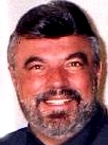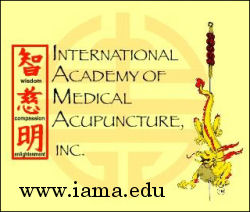Acupuncture & TCM Articles

Acupuncture Articles
by John A. Amaro L.Ac., Dipl.Ac.(NCCAOM), DC
 Dr. Amaro is an internationally known author, lecturer and practitioner beginning his practice of Acupuncture and Chiropractic in 1971. He has led 13 diplomatic Acupuncture study tours of The People's Republic of China escorting more than 500 doctors and practitioners. He has personally studied Acupuncture in nine separate Asian nations. Dr. Amaro is an internationally known author, lecturer and practitioner beginning his practice of Acupuncture and Chiropractic in 1971. He has led 13 diplomatic Acupuncture study tours of The People's Republic of China escorting more than 500 doctors and practitioners. He has personally studied Acupuncture in nine separate Asian nations.
He has received Certification in Acupuncture through the Columbia Institute of Chiropractic in 1973. This was one of the first Acupuncture postgraduate education programs for physicians in North America commencing in 1972.
He has been certified by the Waseda Acupuncture College in Tokyo, Japan in 1974 and graduated from the Chinese Medical Institute, Kowloon, China in 1976. He had previously taken postgraduate studies at the Tai Chung Medical School Taipei, China 1973.
ACUPUNCTURE ORTHOPEDICS UPPER
John A. Amaro L.Ac., Dipl.Ac.(NCCAOM), DC
It is a fact the combined total of all the gastro-intestinal, respiratory, neurologic, dermatologic, circulatory, metabolic, genitourinary, gynecologic and psychiatric conditions seen by doctors of all disciplines internationally, pales in comparison to the overwhelming number of musculo-skeletal conditions presented in professional practices worldwide.
As Doctors of Chiropractic, we are in a unique position to offer more to the general population regarding orthopedic problems than any other type of physician. The typical D.C. reading this article is generally not a subluxation oriented doctor but rather is more apt to use a variety of approaches in the handling of a case beyond simple adjustment of the spine. Physio-therapeutics, nutrition, homeopathy, acupuncture, meridian therapy, exercise etc. have become standard approaches in the treatment of human ailments by the overwhelming majority of D.C.'s in North America if not the world.
The patient who presents themselves to the Doctor of Chiropractic with a rotator cuff injury, a shoulder impingement syndrome or an acute inflammatory process of the infraspinatus tendon, is looking for as much immediate relief as possible. Even though cervical and upper thoracic adjustment may be indicated, that alone will not relieve an acute episode of pain. Anti-inflammatory medications are usually the first and final approach to the treatment of these conditions medically. Often times, they are not as effective as one would hope. The patient is left with a chronic problem which results in extensive physiotherapy and more often than not failure to relieve the condition.
As virtually millions of people are turning toward what used to be called "Alternative" care but which is now commonly referred to as "Complementary", the Chiropractic profession has an opportunity to emerge as the most sought after medical authority in the nation.
The general public is more aware of the stellar benefits of acupuncture today than ever before in its 30-year history in the U.S. I can say without hesitation, acupuncture is still intriguing and very much sought after by the average patient. Now that it has stood the test of time in America, it seems far less scary and mysterious when practiced by qualified chiropractic and medical physicians. It may also be practiced by a variety of non-invasive means, which are as effective if not more so than needle stimulation and considered physiotherapy. Non-invasive stimulation also opens up an entire market place of patients who even though are intrigued with the prospect of acupuncture, would never submit to having needles placed in them. These patients outnumber the patients who would use needles by 7-3.
Traditional Chinese Medicine (TCM) is steeped in legend, myth and folklore. In the practice of acupuncture there are numerous shamanistic approaches that are vital to the general TCM philosophy. As professionals, many of the concepts of acupuncture just do not fit easily into a 21st Century American practice. However, just as we have seen in chiropractic, there are two distinctly different practice approaches, namely "straights" and "mixers", the same scenario occurs in acupuncture.
Just as there is Traditional Chinese Medicine (TCM) there is likewise Medical/Clinical Acupuncture. Do not think for a second I am being critical of TCM as it is extremely effective and it's practitioners experience incredible results. However, Medical/Clinical Acupuncture is much more user friendly for professionals and the clinical results are without question superior.
If one learned how to play the organ and another learned to play the piano, even though they are totally different instruments with similarities, they both play the exact same keys on the keyboard. Thus, we will find even though there are two totally different styles of acupuncture, both use the same identical points with different rationale but with the same clinical response. Even the straight and the mixer still adjust the same spine with different philosophies.
The main thing which is necessary as a chiropractic physician is to achieve the highest level of clinical result in the shortest span of time. To help the patient eliminate, alleviate or drastically reduce their level of pain quickly is paramount. It is far easier to rehabilitate a patient who is not in acute pain. Also, the quicker you help a patient relieve their symptoms the higher the confidence and the more apt a patient is to refer.
In this and future articles, we will be focusing on "Acupuncture Orthopedics" and specific applications to assist the myriad of musculo-skeletal conditions we see clinically. The following three illustrations are perhaps some of the most significant notes you will ever see regarding the elimination of pain in the shoulder, elbow, arm and neck.
Even though much more can be said about the specific applications of acupuncture/Meridian therapy for upper extremity involvement, the points shown on these three illustrations are without question some of the most powerful points on the body for any upper musculo-skeletal condition.
The points shown are the Well, Spring and Stream point of the three yang meridians of the upper extremity namely Large Intestine (LI), Small Intestine (SI) and Triple Heate (TH). The "Well" Point also known as the tsing point and in some circles the "Akabane" point is where the musculo-tendino meridian begins on each of the meridians. The "Spring" point is the most specific point on each meridian for the treatment of any inflammatory condition affecting the meridian. The "Stream" point is the point of selection for any painful stagnation of energy along a meridian, especially when the pain is associated with environmental factors (wind, damp, cold).
For those of you with a background in acupuncture, it is recommended to "Surround the Dragon". That is, to palpate and stimulate any and all points which are tender to touch in the area of pain. These may be either classic acupoints or not. For some of the most incredible clinical results you will ever achieve, stimulate either with a ½ inch metal handled ribbed needle or with non-invasive techniques the total of the nine points illustrated in FigA., FigB and FigC.
The points are extremely easy to locate on the body as they are precisely in the same location as the graphic.
FIG A: FIG B: FIG C: MISSING
Try these nine points on your next 10 cases of upper extremity/neck involvement. Give at least four treatments before you call the case a success or failure. I can practically guarantee, if you use these points, your clinical success in upper extremity conditions will be phenomenal.
Save this article and graphics to add to next months column on the successful condition of lumbalgia, lumbar disc syndrome, sciatic neuralgia, femoral neuralgia, spinal stenosis (pain), knee, ankle, groin and general lower extremity involvements. Best Wishes for a great month!
Treatment of Pain & Musculoskeletal Conditions Books
Biomedical Acupuncture for Pain Management, Acupuncture Treatment for Musculoskeletal Pain, Acupuncture in Physiotherapy.
| 